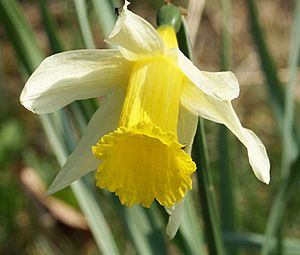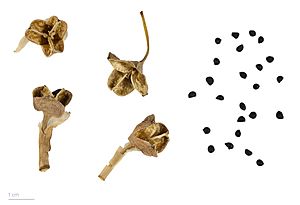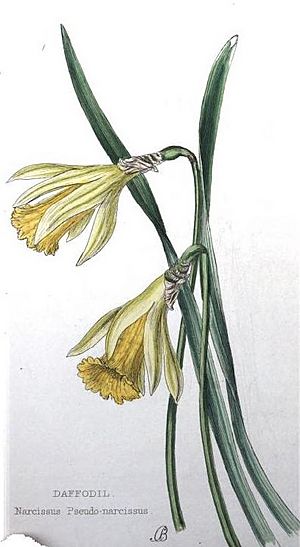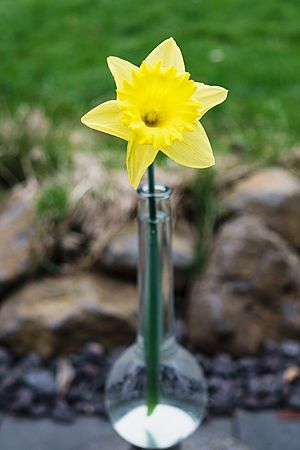Wild daffodil or Lent lily facts for kids
Quick facts for kids Wild daffodil or Lent lily |
|
|---|---|
 |
|
| Scientific classification | |
| Genus: |
Narcissus
|
| Species: |
pseudonarcissus
|
| Synonyms | |
|
See text |
|
The Narcissus pseudonarcissus is a beautiful plant often called the wild daffodil or Lent lily. In Welsh, it's known as Cennin Pedr. This plant is a perennial flowering plant, which means it lives for more than two years and blooms every spring.
Wild daffodils have pale yellow petals, called tepals, and a darker yellow trumpet shape in the middle. Their long, thin leaves are a bit grey-green and grow from the bottom of the stem. The whole plant grows from a round underground part called a bulb. After the flowers bloom, they make seeds. If these seeds grow, it can take five to seven years for a new plant to produce its first flower!
It's important to know that if garden daffodils are planted too close to wild ones, the new plants that grow from seeds might be stronger. This is because they get a mix of traits from both parent flowers. These stronger plants could then take over and reduce the number of true wild daffodils.
Contents
Where Wild Daffodils Grow
Wild daffodils are originally from Western Europe. You can find them from Spain and Portugal all the way east to Germany, and north to England and Wales.
People also grow them in gardens all over the world. Because of this, wild daffodil populations have started growing in new places. These include the Balkans, Australia, New Zealand, and parts of North America like British Columbia and Oregon. They like to grow in woods, grassy areas, and on rocky ground.
In Britain, the number of native wild daffodils has gone down a lot since the 1800s. This happened because of more farming, clearing forests, and people digging up the bulbs for their gardens. In Germany, there was a special campaign in 1981 to help protect these wildflowers.
In England, a large group of wild daffodils grows in the Farndale valley, which is in the North York Moors National Park. There are also several nature reserves in Gloucestershire that have many wild daffodils. You can even follow a "Daffodil Walk Trail" in the spring to see them!
Different Types of Wild Daffodils
There are different types, or subspecies, of the wild daffodil. It can be tricky to count them all because there are also many garden varieties, called cultivars.
One special type is the Tenby daffodil (N. pseudonarcissus ssp. obvallaris). It probably started in gardens but now grows wild in southwest Wales.
Double-Flowered Daffodils
Recently, people who love plants have found some very unique wild daffodils in Wales, southwest England, and northern France. These rare flowers have double petals, meaning they look much fuller than regular daffodils.
Botanists and herbalists knew about these special forms a long time ago, back in the late 1500s and early 1600s. They called them things like "Gerrards double Daffodill." People have collected some of these rare bulbs, and we hope that these unusual types might be available for everyone to grow in their gardens in the future!
National Flower
The daffodil is the national flower of Wales. In Welsh, it's called Cennin Pedr, which means "Peter's Leek." The daffodil is also the county flower for Gloucestershire in England.
Health Risks
It's very important to know that all daffodil plants, including the wild daffodil, contain a natural poison called lycorine. This poison is mostly in the bulb, but it's also in the leaves. Because of this, you should never eat daffodil bulbs or leaves. They are not safe for people or animals to eat.
Images for kids
-
Wild daffodils growing in Hallerbos (Belgium)
See also
 In Spanish: Narcissus pseudonarcissus para niños
In Spanish: Narcissus pseudonarcissus para niños





